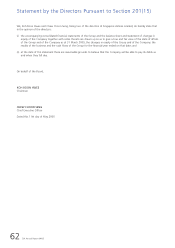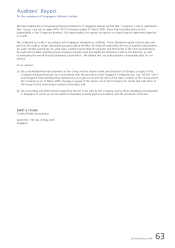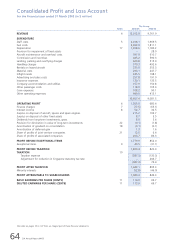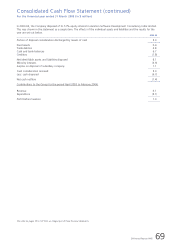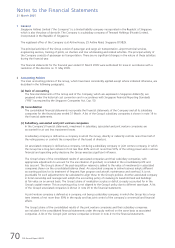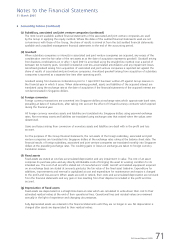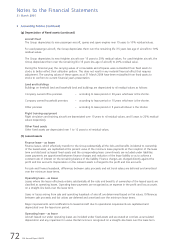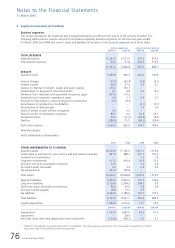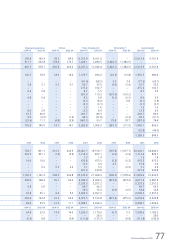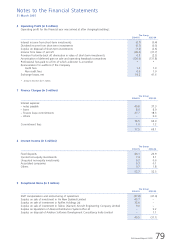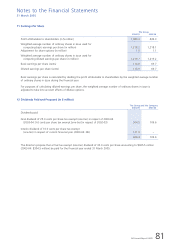Singapore Airlines 2005 Annual Report Download - page 74
Download and view the complete annual report
Please find page 74 of the 2005 Singapore Airlines annual report below. You can navigate through the pages in the report by either clicking on the pages listed below, or by using the keyword search tool below to find specific information within the annual report.72 SIA Annual Report 04/05
Notes to the Financial Statements
31 March 2005
CC
MOD: CN1323
M Y
C K
While every effort has been taken to carry out instruction to customers satisfaction
NO RESPONSIBILITY liablilty will be accepted for errors
CUSTOMERS ARE THEREFOREURGED TO CHECK THOROUGHLY BEFORE
AUTHORISING PRINTRUNS
DALIM
1 2 3 4 5 6 7 8 9 10 OK TS
CC196777 DLMAC13 10.06.2005 150#
13col
2 Accounting Policies (continued)
(g) Depreciation of fixed assets (continued)
Aircraft fleet
The Group depreciates its new passenger aircraft, spares and spare engines over 15 years to 10% residual values.
For used passenger aircraft, the Group depreciates them over the remaining life (15 years less age of aircraft) to 10%
residual values.
The Group depreciates its new freighter aircraft over 15 years to 20% residual values. For used freighter aircraft, the
Group depreciates them over the remaining life (15 years less age of aircraft) to 20% residual value.
During the financial year, the carrying values of consumable aircraft spares were reclassified from fixed assets to
stocks to better reflect their utilisation pattern. This does not result in any material financial effect that requires
adjustment. The carrying values of these spares as at 31 March 2004 have been reclassified from fixed assets to
stocks to conform to current financial year’s presentation.
Land and buildings
Buildings on freehold land and leasehold land and buildings are depreciated to nil residual values as follows:
Company owned office premises – according to lease period or 30 years whichever is the shorter.
Company owned household premises – according to lease period or 10 years whichever is the shorter.
Other premises – according to lease period or 5 years whichever is the shorter.
Flight training equipment
Flight simulators and training aircraft are depreciated over 10 years to nil residual values, and 5 years to 20% residual
values respectively.
Other fixed assets
Other fixed assets are depreciated over 1 to 12 years to nil residual values.
(h) Leased assets
Finance lease – as lessee
Finance leases, which effectively transfer to the Group substantially all the risks and benefits incidental to ownership
of the leased asset, are capitalised at the present value of the minimum lease payments at the inception of the lease
term and disclosed as leased fixed assets and the corresponding lease commitments are included under liabilities.
Lease payments are apportioned between finance charges and reduction of the lease liability so as to achieve a
constant rate of interest on the remaining balance of the liability. Finance charges are charged directly against the
profit and loss accounts. Depreciation on the relevant assets is charged to the profit and loss accounts.
For sale and finance leaseback, differences between sales proceeds and net book values are deferred and amortised
over the minimum lease terms.
Operating lease – as lessee
Leases where the lessor effectively retains substantially all the risks and benefits of ownership of the leased assets are
classified as operating leases. Operating lease payments are recognised as an expense in the profit and loss accounts
on a straight-line basis over the lease term.
Gains or losses arising from sale and operating leaseback of aircraft are determined based on fair values. Differences
between sale proceeds and fair values are deferred and amortised over the minimum lease terms.
Major improvements and modifications to leased aircraft due to operational requirements are capitalised and
depreciated over the lease-term period.
Operating lease – as lessor
Aircraft leased out under operating leases are included under fixed assets and are stated at cost less accumulated
depreciation and any impairment in value. Rental income is recognised on a straight–line basis over the lease term.


